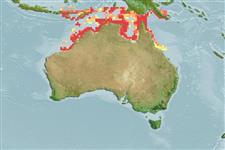>
Eupercaria/misc (Various families in series Eupercaria) >
Labridae (Wrasses) > Bodianinae
Etymology: Choerodon: Greek, choiros = a pig + odous = teeth (Ref. 45335); referrring to the prominent anterior canines of the species in this genus (Ref. 116605).
More on author: Ogilby.
Environment: milieu / climate zone / depth range / distribution range
Ecologie
marien demersaal; diepte 10 - 40 m (Ref. 90102). Tropical
Western Central Pacific: northwestern Australia (Ref. 3131) and Papua New Guinea (Ref. 6192).
Grootte / Gewicht / Leeftijd
Maturity: Lm ? range ? - ? cm
Max length : 25.0 cm TL mannelijk / geslacht onbekend; (Ref. 3132)
Dorsale stekels (totaal): 13; Dorsale zachte stralen (totaal): 7; Anale stekels 3; Anale zachte stralen: 10. Body mostly pale with faint broad dusky bands especially dorsally. A prominent ocellated dark spot present on dorsal fin between last few spines. Body deep at level of dorsal-fin origin (2.3 to 2.6 times in SL). Second prominent anterior canine mostly straight, only slightly curved in large specimens, angled dorsolaterally and sometimes slightly posteriorly.
Adults inhabit flat sandy or weedy areas (Ref. 3131). Found solitary in rubble, silt or sand bottoms (Ref. 90102). Oviparous, distinct pairing during breeding (Ref. 205). A good food fish.
Levenscyclus en paargedrag
Maturiteit | Voortplanting | Paaien | Eieren | Fecunditeit | Larven
Oviparous, distinct pairing during breeding (Ref. 205).
Sainsbury, K.J., P.J. Kailola and G.G. Leyland, 1985. Continental shelf fishes of the northern and north-western Australia. An illustrated guide. CSIRO Division of Fisheries Research; Clouston & Hall and Peter Pownall Fisheries Information Service, Canberra, Australia. 375 p. (Ref. 3131)
Status op de Rode Lijst van het IUCN (Ref. 130435)
Gevaar voor de mens
Harmless
Gebruik door de mens
Meer informatie
ReferentiesAquacultuurAquacultuurprofielKweeklijnenGeneticaElectrophoresesErfelijkheidZiektesVerwerkingNutrientsMassaconversie
Tools
Speciale rapporten
Download XML
Internetbronnen
Estimates based on models
Preferred temperature (Ref.
123201): 24.7 - 28.8, mean 27.7 °C (based on 228 cells).
Fylogenetische diversiteitsindex (Ref.
82804): PD
50 = 0.5000 [Uniqueness, from 0.5 = low to 2.0 = high].
Bayesian length-weight: a=0.01318 (0.00582 - 0.02984), b=3.05 (2.86 - 3.24), in cm total length, based on LWR estimates for this (Sub)family-body shape (Ref.
93245).
Trofisch niveau (Ref.
69278): 3.4 ±0.4 se; based on size and trophs of closest relatives
Weerstandsvermogen (Ref.
120179): Gemiddeld, minimale populatieverdubbelingstijd 1,4-4,4 jaar (Preliminary K or Fecundity.).
Fishing Vulnerability (Ref.
59153): Low vulnerability (15 of 100).
Nutrients (Ref.
124155): Calcium = 174 [90, 339] mg/100g; Iron = 1.15 [0.62, 2.29] mg/100g; Protein = 18.1 [15.3, 20.2] %; Omega3 = 0.264 [0.153, 0.463] g/100g; Selenium = 39.3 [20.4, 81.1] μg/100g; VitaminA = 37.5 [10.4, 146.9] μg/100g; Zinc = 1.24 [0.86, 2.04] mg/100g (wet weight);
